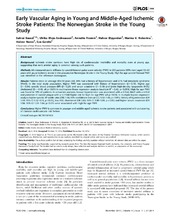| dc.contributor.author | Saeed, Sahrai | en_US |
| dc.contributor.author | Waje-Andreassen, Ulrike | en_US |
| dc.contributor.author | Fromm, Annette | en_US |
| dc.contributor.author | Øygarden, Halvor | en_US |
| dc.contributor.author | Kokorina, Marina Victorovna | en_US |
| dc.contributor.author | Næss, Halvor | en_US |
| dc.contributor.author | Gerdts, Eva | en_US |
| dc.date.accessioned | 2015-03-18T10:00:57Z | |
| dc.date.available | 2015-03-18T10:00:57Z | |
| dc.date.issued | 2014-11-18 | eng |
| dc.identifier.issn | 1932-6203 | |
| dc.identifier.uri | https://hdl.handle.net/1956/9568 | |
| dc.description.abstract | Background: Ischemic stroke survivors have high risk of cardiovascular morbidity and mortality even at young age, suggesting that early arterial aging is common among such patients. Methods: We measured aortic stiffness by carotid-femoral pulse wave velocity (PWV) in 205 patients (69% men) aged 15–60 years with acute ischemic stroke in the prospective Norwegian Stroke in the Young Study. High for age carotid-femoral PWV was identified in the reference normogram. Results: Patients were on average 49±10 years old, 34% had a history of hypertension and 37% had metabolic syndrome (MetS). In the total study population, higher PWV was associated with history of hypertension (β = 0.18), higher age (β = 0.34), systolic blood pressure (BP) (β = 0.28) and serum creatinine (β = 0.18) and lower high-density lipoprotein (HDL) cholesterol (β = –0.10, all p<0.01) in multivariate linear regression analysis (multiple R2 = 0.42, p<0.001). High for age PWV was found in 18% of patients. In univariate analyses, known hypertension was associated with a 6-fold, MetS with a 4-fold and presence of carotid plaque with a 3.7-fold higher risk for high for age PWV (all p<0.01). In multiple logistic regression analysis higher systolic BP (odds ratio [OR] 1.04; 95% confidence interval [CI] 1.02–1.06; p<0.01), history of hypertension (OR 3.59; 95% CI 1.52–8.51; p<0.01), low HDL cholesterol (OR 3.03; 95% CI 1.00–9.09; p = 0.05) and higher serum creatinine (OR 1.04; 95% CI 1.01–1.06; p<0.01) were associated with high for age PWV. Conclusions: Higher PWV is common in younger and middle-aged ischemic stroke patients and associated with a clustering of classical cardiovascular risk factors. | en_US |
| dc.language.iso | eng | eng |
| dc.publisher | Public Library of Science | eng |
| dc.rights | Attribution CC BY | eng |
| dc.rights.uri | http://creativecommons.org/licenses/by/4.0/ | eng |
| dc.title | Early vascular aging in young and middle-aged ischemic stroke patients: The Norwegian stroke in the young study | en_US |
| dc.type | Peer reviewed | |
| dc.type | Journal article | |
| dc.date.updated | 2015-03-03T14:54:03Z | en_US |
| dc.description.version | publishedVersion | en_US |
| dc.rights.holder | Copyright 2014 Saeed et al. This is an open-access article distributed under the terms of the Creative Commons Attribution License, which permits unrestricted use, distribution, and reproduction in any medium, provided the original author and source are credited. | |
| dc.source.articlenumber | e112814 | |
| dc.identifier.doi | https://doi.org/10.1371/journal.pone.0112814 | |
| dc.identifier.cristin | 1212546 | |
| dc.source.journal | PLoS ONE | |
| dc.source.40 | 9 | |
| dc.source.14 | 11 | |
| dc.subject.nsi | VDP::Medical sciences: 700::Clinical medical sciences: 750::Cardiology: 771 | eng |
| dc.subject.nsi | VDP::Medical sciences: 700::Clinical medical sciences: 750::Neurology: 752 | eng |
| dc.subject.nsi | VDP::Medisinske fag: 700::Klinisk medisinske fag: 750::Kardiologi: 771 | nob |
| dc.subject.nsi | VDP::Medisinske fag: 700::Klinisk medisinske fag: 750::Nevrologi: 752 | nob |

